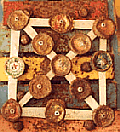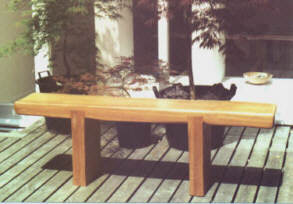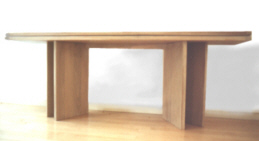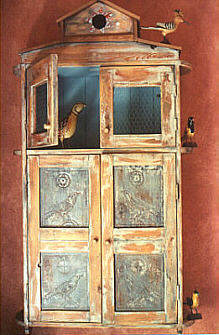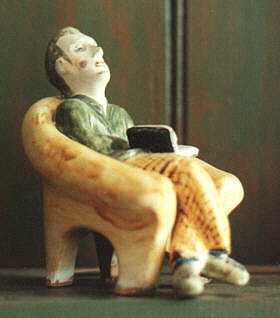- extraction
of methods from:
-
- WORKSHOP RECEIPTS
- for the use of
- Manufacturers. Mechanics, and Scientific
Amateurs
- by Ernest Spon
- 1883
Crayons,Method of Making.
-White paste,used for white crayons or for
a body for other colours:-1. Washed pipe-clay and washed chalk
equal parts, mix them into paste with sweet ale made hot, and
with a chip or two of isinglass dissolved in it.2. Take the finest
powder of calcined oyster shells, sifted through muslin, mix
it up with water in which a little rice and a little white sugar
candy has been boiled; according to the quantity of rice, so
will be the hardness of the crayon. The quantity of sugar -candy
should not be more than the size of a filbert-nut to a pint of
water.3.Take common pipe-clay in powder, mix it up into paste
with very strong soapsuds, made thus:-Cut up an ounce of white
soap into small shavings, dissolve it over the fire in 1/2 pint
of water, stir into the mixture while hot the powdered pipe clay
as long as you can stir it. Spirits of wine added before the
powders render the soap-water transparent, is an improvement.
The compositions for white crayons and the
requisite colours being prepared, and that chosen made up into
a stiff paste, it is to be placed upon a smooth slab of marble
slightly oiled. The paste is rolled with a rolling pin, then
cut into slips and these rolled into cylinders by the aid of
a little flat piece of wood, then cut to the length of 3 inches
each, and placed in a slow oven or drying stove to become hard.
- Crayons, colours for.- When made with powdered
colours; the proper way of mixing is to dissolve the colour first
in water or spirits of wine, and add it to nearly -dry white
colour, grinding the whole together.
-
-
- Transparent painting on Linen.-
- The colours used in transparent painting
are mixed with meglip as a vehicle, except in the case of very
light colours, when turpentine and copal varnish must be used.
The material upon which transparencies are executed is fine muslin;
and this, before being worked upon, should be strained in a straining
frame, and sized with either gilders size, or fine colourless
gelatin dissolved and properly diluted. After the first coat
of size is dry the muslin will slacken and hang loosely on the
frame. It should be stretched; another coat of size applied;
and when dry the muslin again extended. The design having been
prepared, it may be traced, copied, pounced or stencilled upon
the prepared muslin, care being taken that the outline from which
the tracing is made consists of strong and decided lines, that
stencil plates are made of oiled paper, and that powdered charcoal
is used in preference to any other powder for pouncing. For very
fine tints sponge can be used with great advantage to rub in
broad flat tints, however delicate. Fine effects may be produced
by the use of two transparencies, arranged one behind the other.
-
- Colours.- For colouring drawings, the most
soluble, brilliant, and transparent water- colours are used;
this particularly applies to plans and sections. The colour is
not so much intended to represent that of the material to be
used in the construction, as to clearly distinguish one material
from another employed on the same work.
- The following table shows the colours most
employed by the profession:-
-
- Carmine or Crimson lake........ brickwork
- Prussian Blue.........................flint
work, or lead
- Violet Carmine........................granite
- Raw Sienna............................timber
- Indian Yellow.........................pine,
spruce
- Indian Red.............................mahogany
- Sepia.....................................concrete,
stone
- Burnt Umber..........................clay,
earth
- Payne's Grey..........................cast
iron, ironwork
- Dark Cadmium.......................gun metal
- Gamboge................................brass
- Indigo.....................................steel
- Hooker's Green.......................meadow
land
- Cobalt Blue.............................sky
- wwwww
|


